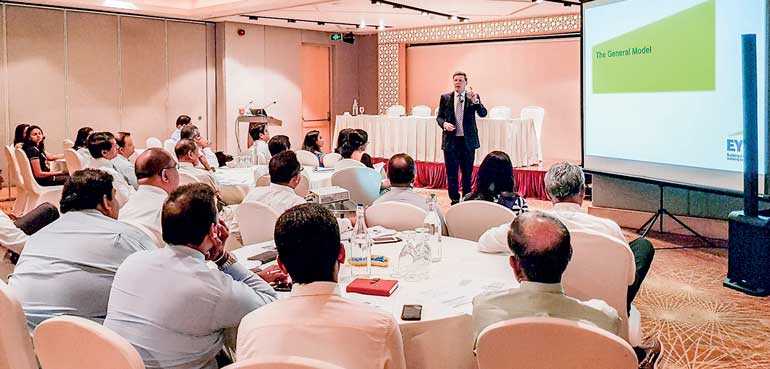Friday Jan 02, 2026
Friday Jan 02, 2026
Tuesday, 4 September 2018 00:00 - - {{hitsCtrl.values.hits}}


Ernst & Young (EY) Sri Lanka hosted its clients to a forum on sharing insights on the practical implementation of IFRS 17 – Insurance contracts, an accounting standard that has caused quite an uproar in the Sri Lankan market. IFRS 17 will be effective from 1 January 2021 and the exposure draft of the standard has been issued by CA Sri Lanka.
The event was attended by Audit Committee Chairpersons, CEOs and CFOs of insurance companies in Sri Lanka. The local leadership of the firm, and the Insurance Leader in Oceania Kieren Cummings, addressed the gathering. Manil Jayesinghe the Assurance Leader of EY Sri Lanka, welcomed the invitees, highlighting the need for urgent action on evaluating the impact arising from the standard on insurance companies. “The accounting impact for long term contracts, i.e. life contracts is much severe, but the shorter life contracts will also need a significant amount of work to apply the standard,” he said.
At the event, Kieren unravelled the mystery of applying the standard through sharing of insights and implementation considerations. Kieren highlighted the following during his presentation, where he shared his experience of supporting clients to implement IFRS 17 over the last 18 months.
n Long term insurance contracts will need to be segmented based on similar risk characteristics. This will require an entity to evaluate its entire active insurance portfolio.
n Thereafter the segments will be evaluated to identify, contracts that are expected to be onerous at initial recognition, No significant possibility of being onerous as at initial recognition and other expected resilience at initial recognition.
n The standard also restricts the model to be applied to annual cohorts. Hence, each portfolio will be further segmented to one year cohorts throughout the contract period.
Thereafter, in order to calculate the liability, future cash flows, risk adjustment, discount rate, etc. needs to be estimated for each identified segment. This method is called the General Model, or the Building Block approach. The amount of data involved for such an exercise can be overwhelming. Kieren also highlighted that for contracts that are one year or less, the standard allows a simpler approach where the liability is measured based on the premium received. This is called the Premium Allocation Approach. For contracts with direct participating features, Variable Fee Approach is available.
One Chief Financial Officer (CFO) raised the question: “How will these measurement models represent the insurance liability under IFRS 17?” Kieren responded: “It splits the liability into two components, the liability for remaining coverage (LFRC) and the liability for incurred claims (LFIC). LFRC represent the amounts that the insurer expects to hold for events that have not yet happened. LFIC represents the amounts the insurer expects to pay for claims that have already incurred. In measuring LFRC the entities must determine the most suited model out of the three, namely, Building Block approach (BBA), Premium Allocation Approach (PAA) and Variable Fee Approach (VFA). This will enable the entity to recognise the liability as well as recognise the profit in a systematic manner, based on the type of contract.”
EY expects that most life insurance contracts will be measured under BBA, whilst, the contracts that are less than 1 year may be subjected to the simpler model that is PAA.
A CEO in the audience requested Kieren to share very briefly a few tips for a company that is just starting implementing IFRS 17. Kieren shared the following with the audience in order to address this query. “It was found very useful for an entity to carry out an operational impact assessment. This is the fastest way to find out the high risk areas. Typically it will take about eight weeks. It involves a series of workshops and diagnosis that will start the journey of orienting the company with IFRS 17.”
Thereafter, Jayasinghe provided his insights in relation to the Sri Lankan insurance industry and stressed: “Sri Lankan entities must also commence a thorough review of its contracts, as this will be critical evaluation for the determination of the portfolios within the entity to which IFRS 17 must be applied. We have already identified a few contracts that companies perceived to be one year contracts, and expected to follow PAA, that turned out to be longer term contracts requiring BBA measurement.”
Many participants questioned whether the new standard will enable companies to manipulate results due to the significant estimates that are required. For example, one CFO asked questioned whether the risk adjustment in computing fulfilment cashflows will be used to manipulate results. However, the standard considers all future cash flows including future premiums and claims, in computing the liability, and any changes are reflected in the contractual service margin (CSM) which is the estimate of the deferred profit on the contract. The disclosures required by the standard will also ensure comparability and consistency in financial reporting.
Kieren concluded that the standard is undoubtedly complex, but with the right tools, knowledge and experience companies can expect to have less turmoil.